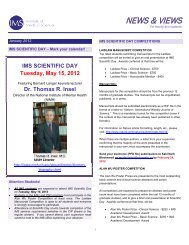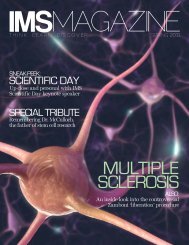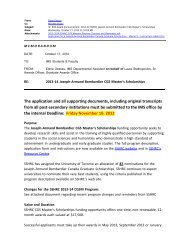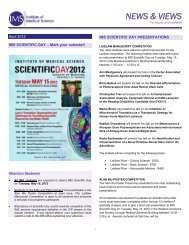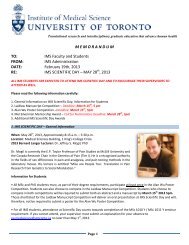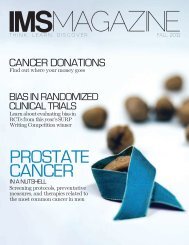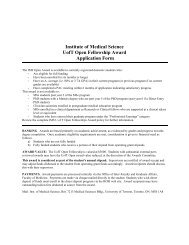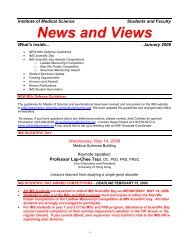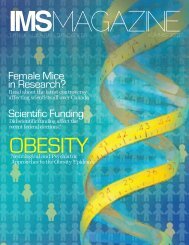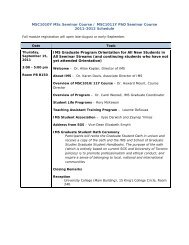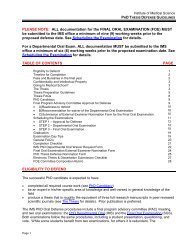IMS Magazine - Summer 2012 edition in PDF format - Institute of ...
IMS Magazine - Summer 2012 edition in PDF format - Institute of ...
IMS Magazine - Summer 2012 edition in PDF format - Institute of ...
Create successful ePaper yourself
Turn your PDF publications into a flip-book with our unique Google optimized e-Paper software.
FEATURE<br />
Epigenomics<br />
Beyond Genomic Sequenc<strong>in</strong>g<br />
Darci Butcher, PhD, Postdoctoral<br />
Fellow<br />
Program <strong>in</strong> Genetics and Genome Biology,<br />
Hospital for Sick Children<br />
Rosanna Weksberg, MD, PhD<br />
Staff Physician, Cl<strong>in</strong>ical and Metabolic<br />
Genetics<br />
Co-Director and Staff Geneticist, Cancer<br />
Genetics Program<br />
The Hospital for Sick Children<br />
Pr<strong>of</strong>essor,<br />
Molecular and Medical Genetics<br />
University <strong>of</strong> Toronto<br />
Genome sequenc<strong>in</strong>g <strong>in</strong>itiatives<br />
have been unable to identify the<br />
genetic causes or phenotypic modulators<br />
<strong>of</strong> many <strong>of</strong> disorders seen <strong>in</strong> cl<strong>in</strong>ical<br />
medic<strong>in</strong>e. Layered on top <strong>of</strong> the DNA<br />
sequence is epigenetic <strong>in</strong><strong>format</strong>ion, def<strong>in</strong>ed<br />
as a “stably heritable phenotype result<strong>in</strong>g<br />
from changes <strong>in</strong> a chromosome without alterations<br />
<strong>in</strong> the DNA sequence” 1 . Identify<strong>in</strong>g<br />
the epigenetic marks and characteriz<strong>in</strong>g how<br />
they are read to regulate the expression <strong>of</strong> the<br />
primary genomic sequence is necessary for<br />
our understand<strong>in</strong>g <strong>of</strong> human development<br />
and disease. Multiple epigenetic mechanisms<br />
<strong>in</strong>clud<strong>in</strong>g DNA methylation at cytos<strong>in</strong>e<br />
residues <strong>in</strong> CpG d<strong>in</strong>ucleotides, covalent<br />
modifications <strong>of</strong> histone prote<strong>in</strong>s, regulatory<br />
non-cod<strong>in</strong>g RNAs, <strong>in</strong>clud<strong>in</strong>g small <strong>in</strong>terfer<strong>in</strong>g<br />
RNA (siRNA), microRNAs (miRNAs)<br />
and long non-cod<strong>in</strong>g RNAs (lncRNAs) participate<br />
<strong>in</strong> regulat<strong>in</strong>g gene expression and<br />
chromat<strong>in</strong> architecture. Disruption <strong>of</strong> these<br />
mechanisms is associated with a variety <strong>of</strong><br />
diseases with behavioural, endocr<strong>in</strong>e or neurologic<br />
manifestations and disorders <strong>of</strong> tissue<br />
growth, <strong>in</strong>clud<strong>in</strong>g cancer. The <strong>in</strong>volvement <strong>of</strong><br />
epigenetic alterations <strong>in</strong> many diseases has<br />
been known for some time, but only recently<br />
has it begun to be useful for cl<strong>in</strong>ical practice<br />
to diagnose and monitor disease progression.<br />
In the Weksberg laboratory we determ<strong>in</strong>e<br />
genome-wide differential DNA methylation,<br />
gene expression and histone modifications<br />
for a number <strong>of</strong> disorders that have known<br />
or suspected aberrations <strong>in</strong> their epigenomic<br />
patterns. Many <strong>of</strong> these projects are collaborative<br />
efforts between the research laboratory<br />
and cl<strong>in</strong>icians at the Hospital for Sick<br />
Children and around the world. We are identify<strong>in</strong>g<br />
genes and pathways that have altered<br />
DNA methylation to determ<strong>in</strong>e their contribution<br />
to the overall disease phenotype. The<br />
projects <strong>in</strong> the laboratory can be separated<br />
<strong>in</strong>to those related to growth, <strong>in</strong>clud<strong>in</strong>g genomic<br />
impr<strong>in</strong>t<strong>in</strong>g and <strong>in</strong>trauter<strong>in</strong>e growth<br />
restriction and those related to neurodevelopment<br />
<strong>in</strong>clud<strong>in</strong>g autism spectrum disorders<br />
(ASD) and other paediatric neuropsychiatric<br />
disorders.<br />
A number <strong>of</strong> disorders are caused by aberrant<br />
genomic impr<strong>in</strong>t<strong>in</strong>g result<strong>in</strong>g from unequal<br />
contributions <strong>of</strong> maternal and paternal<br />
alleles to the <strong>of</strong>fspr<strong>in</strong>g 2 . Impr<strong>in</strong>ted genes<br />
typically function <strong>in</strong> growth regulation and<br />
neurodevelopment, and the correspond<strong>in</strong>g<br />
disease phenotypes are due to genetic or epigenetic<br />
aberrations <strong>in</strong> these genes <strong>of</strong>ten result<br />
<strong>in</strong> abnormalities <strong>of</strong> <strong>in</strong>trauter<strong>in</strong>e growth<br />
or post-natal cognition and behavior. These<br />
disorders <strong>in</strong>clude Beckwith-Wiedemann<br />
(BWS), Silver-Russell (SRS), Prader-Willi<br />
(PWS) and Angelman syndromes (AS).<br />
The molecular and epigenetic causes <strong>of</strong><br />
Beckwith-Wiedemann syndrome have been<br />
studied <strong>in</strong> depth <strong>in</strong> the Weksberg laboratory 3 .<br />
This disorder is a rare, <strong>of</strong>ten sporadic, heterogeneous<br />
congenital overgrowth disorder<br />
which has many features <strong>in</strong>clud<strong>in</strong>g somatic<br />
overgrowth, large tongue, abdom<strong>in</strong>al wall<br />
defects, ear creases and pits, kidney mal<strong>format</strong>ions<br />
and neonatal hypoglycemia, as well<br />
as <strong>in</strong> <strong>in</strong>creased risk <strong>of</strong> embryonal tumours.<br />
BWS is caused by epigenomic and/or genomic<br />
alterations <strong>in</strong> the impr<strong>in</strong>ted gene clusters<br />
on chromosome band 11p15.5 4 can be subdivided<br />
<strong>in</strong>to two dist<strong>in</strong>ct impr<strong>in</strong>ted doma<strong>in</strong>s.<br />
Most cases <strong>of</strong> BWS are due to epigenetic lesions:<br />
either a ga<strong>in</strong> <strong>of</strong> CpG methylation at an<br />
impr<strong>in</strong>t<strong>in</strong>g control region on the maternal allele<br />
<strong>of</strong> the H19 upstream differentially methylation<br />
region (DMR), which silences H19<br />
and activates expression <strong>of</strong> the growth promot<strong>in</strong>g<br />
gene <strong>in</strong>sul<strong>in</strong> growth factor 2 (IGF2),<br />
or a loss <strong>of</strong> methylation at another impr<strong>in</strong>t<strong>in</strong>g<br />
control region <strong>of</strong> the KCNQ1<strong>in</strong>tronic DMR,<br />
which silences the growth suppressor gene<br />
CDKN1C plus several nearby maternally expressed<br />
genes. Identify<strong>in</strong>g specific molecular<br />
defects <strong>in</strong> impr<strong>in</strong>t<strong>in</strong>g disorders provides im-<br />
Photos by Brett Jones<br />
21 | <strong>IMS</strong> MAGAZINE SUMMER <strong>2012</strong> GENOMIC MEDICINE



